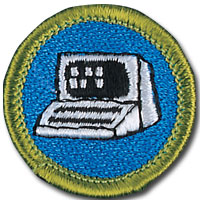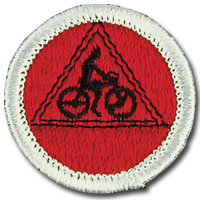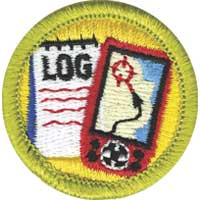Scouting/Merit Badges
< Scouting
Merit Badges
http://www.scouting.org/scoutsource/BoyScouts/AdvancementandAwards/MeritBadges.aspx
Computers

Computers - http://www.scouting.org/scoutsource/BoyScouts/AdvancementandAwards/MeritBadges/mb-COMP.aspx
Requirements:
- Discuss with your counselor the tips for online safety.
- Give a short history of the computer. Explain how the invention of the computer has affected society and science and technology.
- Do the following:
- Describe four uses of computers outside your home.
- Describe three ways you and your family could use a personal computer other than for games and entertainment.
- Explain the following to your counselor:
- The five major parts of a computer
- How text, sound, pictures, and video files are stored in a computer's memory
- How file compression works and how compression affects the quality of the file
- Describe two computer chip–based devices, and describe how they are "smarter" because of the chip and its program.
- Do the following:
- Explain what a program or software application is and how it is developed.
- Name three programming languages and describe their uses.
- Name four software packages you or your family could use, and explain how you would use them.
- Discuss ways you can help protect a computer from viruses and how to protect the information stored on a computer.
- Describe how computers are linked to generate and access the Internet and the World Wide Web.
- Do THREE of the following:
- Using a spreadsheet program, develop a food budget for a patrol weekend campout.
- Using a word processor, write a letter to the parents of your troop's Scouts, inviting them to a court of honor.
- Using a computer graphics program, design and draw a campsite plan for your troop.
- Using a computer graphics program, create a flier for an upcoming troop event, incorporating both text and some type of visual such as a photograph or illustration.
- Using an Internet search engine (with your parent's permission), find ideas about how to conduct a troop court of honor or campfire program. Print out a copy of the ideas from at least three different websites. Share what you found with your counselor, and explain how you used the search engine to find this information.
- Using a presentation software program of your choice, develop a report about a topic that has been approved by your counselor. For your presentation, create at least 10 slides.
- Using a digital camera, take a picture of a troop activity. Transfer the picture file to a computer and use photographic software to make it small enough to send easily as an email attachment. Then, using a computer connected to the Internet (with your parent's permission), send an email to someone you know. In your message, include the photograph as an attachment. Verify that the person received your email and was able to view the attachment.
- Using a database manager, create a troop roster that includes the name, rank, patrol, and telephone number of each Scout. Show your counselor that you can sort the register by each of the following categories: rank, patrol, and alphabetically by name.
- Do ONE of the following:
- Using a database program of your choice, create a troop roster that can be sorted by the name, rank, patrol, and telephone number of each Scout. Create a form within the database manager to access each Scout's information individually. Show your counselor how the form works.
- Using a software package of your choice for computer-aided design (CAD), create an engineering-style drawing of a simple object. Include the top, bottom, and at least one side view and the dimensions.
- Create a blog and use it as an online journal of your Scouting activities, including group discussions and meetings, campouts, and other events. Your blog should have at least five entries and two photographs or illustrations. You need not post the blog to the Internet, but you will need to share it with your counselor. If you decide to go live with your blog, you must first share it with your parents AND counselor and get their approval.
- Create a web page for your troop, patrol, school, or place of worship. Include at least three articles and two photographs or illustrations. Your web page should have at least one link to a website that would be of interest to your audience. You need not post the page to the Internet. However, if you decide to do so, you must first share it with your parents AND counselor and get their approval.
- Visit a business or an industrial plant that uses computers. Observe what tasks the computers accomplish, and be prepared to discuss what you have learned.
- Explain the following to your counselor:
- Why copyright laws exist
- Why it is not permissible to accept a free copy of a paid, copyrighted computer game or program from a friend unless the game or program is considered freeware or shareware. Explain the concepts of freeware and shareware.
- The restrictions and limitations of downloading music from the Internet
- Find out about three career opportunities in the computer industry. Pick one and find out the education, training, and experience required for this profession. Discuss this with your counselor, and explain why this profession might interest you. Report what you learn to your counselor.
Cycling

Cycling - http://www.scouting.org/scoutsource/BoyScouts/AdvancementandAwards/MeritBadges/mb-CYCL.aspx
Requirements:
- Show that you know first aid for injuries or illnesses that could occur while cycling, including hypothermia, heat reactions, frostbite, dehydration, insect stings, tick bites, snakebites, blisters, and hyperventilation.
- Clean and adjust a bicycle. Prepare it for inspection using a bicycle safety checklist. Be sure the bicycle meets local laws.
- Show your bicycle to your counselor for inspection. Point out the adjustments or repairs you have made. Do the following:
- Show all points that need oiling regularly.
- Show points that should be checked regularly to make sure the bicycle is safe to ride.
- Show how to adjust brakes, seat level and height, and steering tube.
- Describe how to brake safely with foot brakes and with hand brakes.
- Show how to repair a flat. Use an old bicycle tire.
- Take a road test with your counselor and demonstrate the following:
- Properly mount, pedal, and brake, including emergency stops.
- On an urban street with light traffic, properly execute a left turn from the center of the street; also demonstrate an alternate left-turn technique used during periods of heavy traffic.
- Properly execute a right turn.
- Demonstrate appropriate actions at a right-turn-only lane when you are continuing straight.
- Show proper curbside and road-edge riding. Show how to ride safely along a row of parked cars.
- Cross railroad tracks properly.
- Describe your state's traffic laws for bicycles. Compare them with motorvehicle laws. Know the bicycle safety guidelines.
- Avoiding main highways, take two rides of 10 miles each, two rides of 15 miles each, and two rides of 25 miles each. You must make a report of the rides taken. List dates, routes traveled, and interesting things seen.*
- After fulfilling requirement 8, lay out on a road map a 50-mile trip. Stay away from main highways. Using your map, make this ride in eight hours.
Geocaching

Geocaching - http://www.scouting.org/scoutsource/BoyScouts/AdvancementandAwards/MeritBadges/mb-GEOCACHE.aspx
Requirements:
- Do the following:
- Explain to your counselor the most likely hazards you may encounter while participating in geocaching activities, and what you should do to anticipate, help prevent, mitigate, and respond to these hazards.
- Discuss first aid and prevention for the types of injuries or illnesses that could occur while participating in geocaching activities, including cuts, scrapes, snakebite, insect stings, tick bites, exposure to poisonous plants, heat and cold reactions (sunburn, heatstroke, heat exhaustion, hypothermia), and dehydration.
- Discuss how to properly plan an activity that uses GPS, including using the buddy system, sharing your plan with others, and considering the weather, route, and proper attire.
- Discuss the following with your counselor:
- Why you should never bury a cache
- How to use proper geocaching etiquette when hiding or seeking a cache, and how to properly hide, post, maintain, and dismantle a geocache
- The principles of Leave No Trace as they apply to geocaching
- Explain the following terms used in geocaching: waypoint, log, cache, accuracy, difficulty and terrain ratings, attributes, trackable. Choose five additional terms to explain to your counselor.
- Explain how the Global Positioning System (GPS) works. Then, using Scouting's Teaching EDGE, demonstrate to your counselor the use of a GPS unit. Include marking and editing a waypoint, changing field functions, and changing the coordinate system in the unit.
- Do the following:
- Show you know how to use a map and compass and explain why this is important for geocaching.
- Explain the similarities and differences between GPS navigation and standard map-reading skills and describe the benefits of each.
- Explain the UTM (Universal Transverse Mercator) system and how it differs from the latitude/longitude system used for public geocaches.
- Show how to plot a UTM waypoint on a map. Compare the accuracy to that found with a GPS unit.
- Describe to your counselor the four steps to finding your first cache. Then mark and edit a waypoint.
- With your parent's permission*, go to www.geocaching.com. Type in your zip code to locate public geocaches in your area. Share with your counselor the posted information about three of those geocaches. Then, pick one of the three and find the cache.
- Do ONE of the following:
- If a Cache to Eagle ® series exists in your council, visit at least three of the locations in the series. Describe the projects that each cache you visit highlights, and explain how the Cache to Eagle ® program helps share our Scouting service with the public.
- Create a Scouting-related Travel Bug ® that promotes one of the values of Scouting. "Release" your Travel Bug into a public geocache and, with your parent's permission, monitor its progress at www.geocaching.com for 30 days. Keep a log, and share this with your counselor at the end of the 30-day period.
- Set up and hide a public geocache, following the guidelines in the Geocaching merit badge pamphlet. Before doing so, share with your counselor a six-month maintenance plan for the geocache where you are personally responsible for the first three months. After setting up the geocache, with your parent's permission, follow the logs online for 30 days and share them with your counselor.
- Explain what Cache In Trash Out (CITO) means, and describe how you have practiced CITO at public geocaches or at a CITO event. Then, either create CITO containers to leave at public caches, or host a CITO event for your unit or for the public.
- Plan a geohunt for a youth group such as your troop or a neighboring pack, at school, or your place of worship. Choose a theme, set up a course with at least four waypoints, teach the players how to use a GPS unit, and play the game. Tell your counselor about your experience, and share the materials you used and developed for this event.
Scuba Diving

Scuba Diving - http://www.scouting.org/scoutsource/BoyScouts/AdvancementandAwards/MeritBadges/mb-scuba.aspx
Requirements:
- Do the following:
- Show that you know first aid for injuries or illnesses that could occur while scuba diving, including hypothermia, hyperventilation, squeezes, decompression illness, nitrogen narcosis, motion sickness, fatigue, overexertion, heat reactions, dehydration, injuries by aquatic life, and cuts and scrapes.
- Identify the conditions that must exist before performing CPR on a person, and explain how to recognize such conditions. Demonstrate the proper technique for performing CPR using a training device approved by your counselor.
- Before completing requirements 3 through 6, earn the Swimming merit badge.
- Discuss the Scuba Diver's Code with your merit badge counselor, and explain the importance of each guideline to a scuba diver's safety.
- Earn an Open Water Diver Certification from a scuba organization recognized by the Boy Scouts of America scuba policy.
- Explain what an ecosystem is, and describe four aquatic ecosystems a diver might experience.
- Find out about three career opportunities in the scuba industry. Pick one and find out the education, training, and experience required for this profession. Discuss this with your counselor, and explain why this profession might interest you.